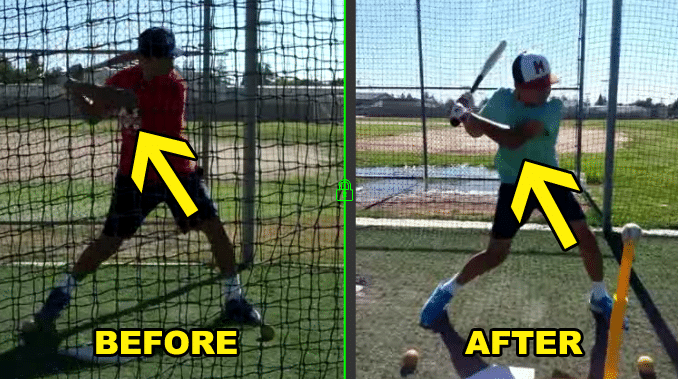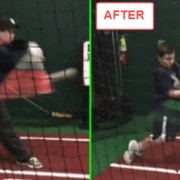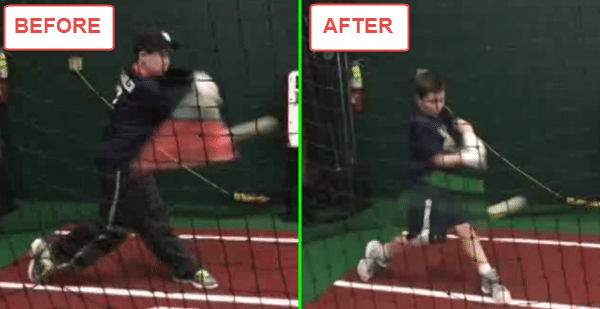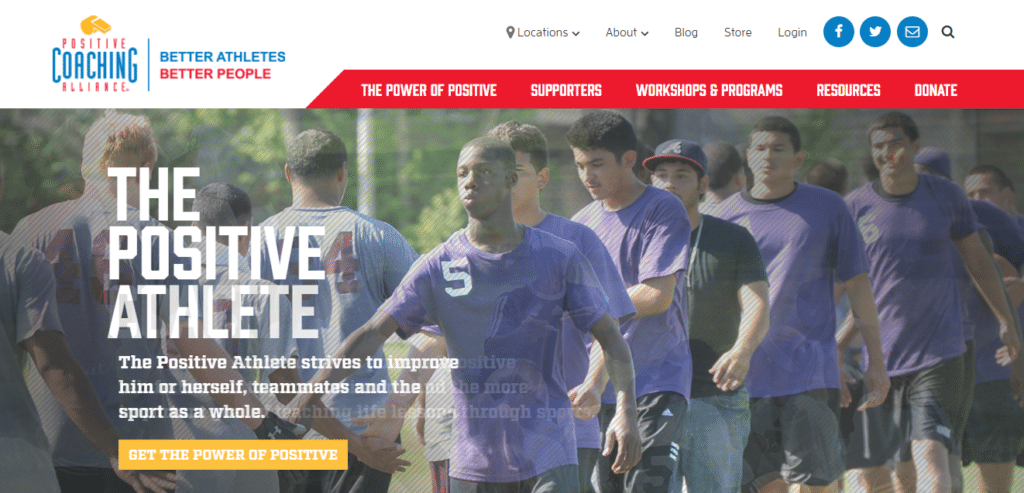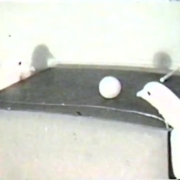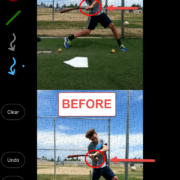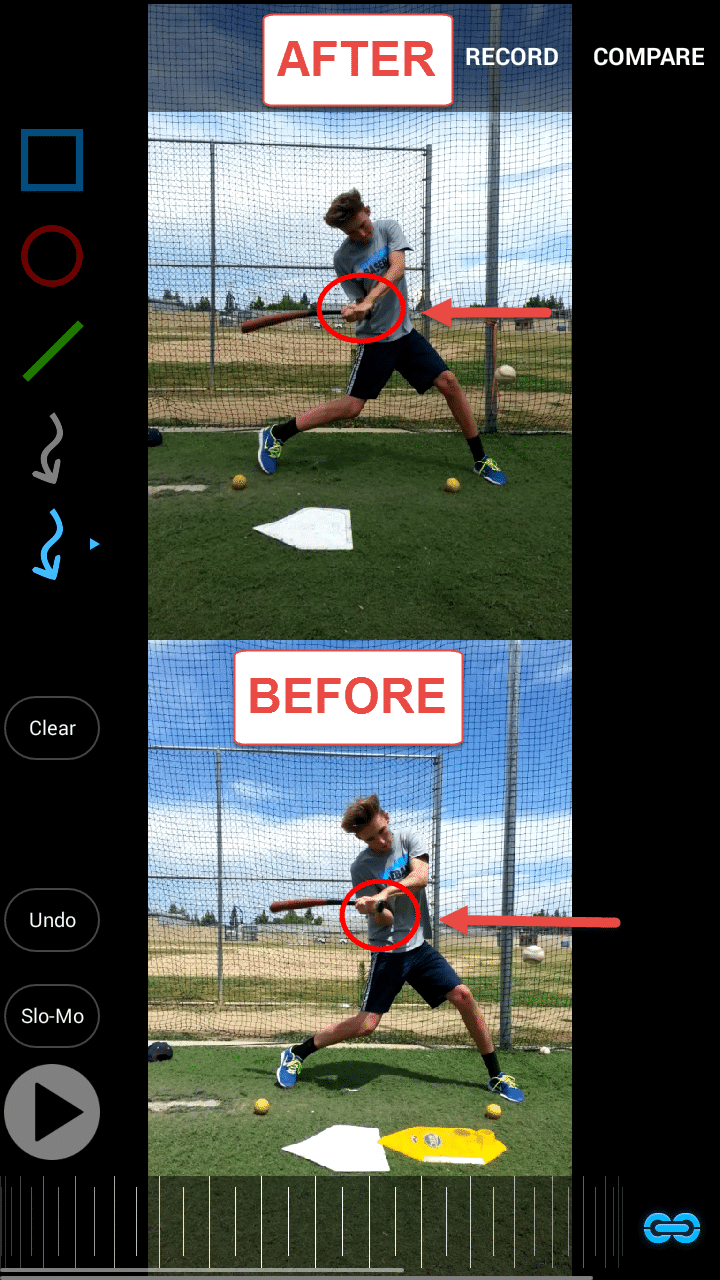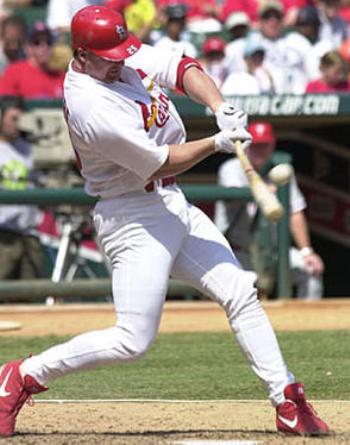Fun ways to teach a beginner kid (get them to buy in) to hit with power and improve batting timing for baseball and softball players. Helpful drills and tips for 4, 6, 8, 9, 10, & 12 year olds.
Softball Hitting Tips for Beginners: 5 Little Known Ways To Improve Hitters

This is one of my online lessons out in Pennsylvania (I’m in Cali), 11yo Jackson. 2.5 months between BEFORE/AFTER’s.
A great softball hitting tips for beginners question came in recently, from a reader (relates well to baseball too)…
“What percentage of hitters that you have coached got no improvement or no benefit from your program? How many swings per day would you recommend for a 10yr old hitter (what’s too much and not enough?”
Here’s what we’ll cover in this softball hitting tips for beginners post:
- Improvement depends on these 5 things…, AND
- How many swings are too much & not enough?
Improvement Depends on these 5 Things…

This is one of my online fastpitch hitters 15yo Mia out in Florida.
I’d be lying to you if I said that ALL my online and local hitters are continually improving or benefiting from my system.
Sadly, this holds true for anyone’s system…effective or ineffective.
Unless…
The instructor is HIGHLY selective on who they accept as a client.
Although, it must be said those hitters being taught ineffective mechanics will get cut much sooner than ones learning how to hit employing human movement principles that are validated by science.
We coaches and instructors can control only so much.
We’re like a flashlight guiding the way in the dark. We can illuminate where we want the hitter to go and how to get there, but ultimately it’s up to the hitter to do their homework.
Here are FIVE critical factors for seeing constant improvement with hitters…
SCIENCE-BASED TRAINING:
Improve your hitting strategy dramatically by applying human movement principles.
Learn not only how and what to train but also the science behind the methods.
Softball Hitting Tips for Beginners #1: Motivation/Inspiration
Like Tony Robbins says, “Motivation is like a warm bath”. Motivation wears off in the short term. But inspiration can last up to months, if not years, from its inception.
There’s a time and place for each.
Think of motivation as PUSHING the player, whereas inspiration allows them to be PULLED by their own self-motivation.
The latter is obviously ideal, but the challenge is that every player is inspired and motivated by different things.
There’s nothing more frustrating for a hitting coach or the parents, than an unmotivated and/or uninspired player…
Which we may have to face the conclusion that this player is probably not in the right sport or activity.
Softball Hitting Tips for Beginners #2: Effective mechanics
Is the hitter applying human movement principles – that are validated by science – to hitting a ball?
You see, effectiveness is doing the right things, while efficiency is doing those things right.
In other words, I can get real good at ‘squashing the bug’, ‘chopping down on the ball’, and ‘sitting back’ but my playing career will be dwarfed in comparison to executing more effective body movements.
One of the biggest competitive advantages I would recommend to any coach, would be to invest and read Thomas Myers’s book Anatomy Trains . Here’s a short video from Thomas Myers explaining “What is Tensegrity”:
. Here’s a short video from Thomas Myers explaining “What is Tensegrity”:
https://youtu.be/BzgxYpDyO0M
Softball Hitting Tips for Beginners #3: Effective coaching cues
As most of you coaches know, player learning styles are different. Do you know how many learning styles there are?
Here’s a clue…
Neuro-Linguistic Programming, or NLP, says there are 3 main ones (acronym – VAK):
- Visual (sight/pictures),
- Auditory (sound), and
- Kinesthetic (feel).
Furthermore, vague coaching cues like ‘get on top of the ball’ or ‘be short to the ball’, which can be used effectively as adjustment cues, are too general and broad in scope to teach as a default swing strategy.
Without extended explanation, these cues aren’t very intuitive, and are ultimately ineffective on a broad scale.
On the other hand, ‘show your numbers to the pitcher’ or ‘land shorter’, will require minimal explanation to get the hitter executing exactly what you want them to do.
Softball Hitting Tips for Beginners #4: Feedback systems
I think it was Peter Drucker that said what gets measured, gets managed.
If you’re a hitting coach that DOES NOT use slow motion analysis, then you’re not being effective.
With free slow motion video phone apps like CoachesEye and HudlTech, and inexpensive PC/MAC software like Powerchalk, there’s ZERO excuse to not do slow motion analysis with your hitters.
Also, swing apps like Zepp, SwingTracker , and the more expensive HitTrax cage system are great for getting more in depth in measuring a hitter’s outcomes.
, and the more expensive HitTrax cage system are great for getting more in depth in measuring a hitter’s outcomes.
You can also use Pocket Radar or a Bushnell radar gun
or a Bushnell radar gun to measure Ball Exit Speeds.
to measure Ball Exit Speeds.
There are also intuitive hitting aids out there that help to cut down the learning curve when teaching a hitter specific swing movements. One inexpensive one giving audible feedback of when the barrel is accelerating is the Swing Blaster .
.
The point is, there are great forms of technology and a few hitting aids out there to aid in your feedback systems. These modalities give hitters INSTANT feedback on where to improve.
Softball Hitting Tips for Beginners #5: Doing the work
This shouldn’t come as a shock to anyone. Even if you’ve checked the previous FOUR factors off your list, if the hitter isn’t putting the work in, then they’ll get better…but can take years to see consistent improvement.
The overarching theme of Arnold Schwarzenegger’s biography, in his tell all book Total Recall , was:
, was:
- Goals,
- Steps, and then
- Reps.
You see, if the hitter is inspired/motivated, employing effective mechanics and coaching cues, using feedback systems to manage what’s measurable, then it’s all about putting the work in.
Do the right things, then get outstanding at doing those things right.
'Add 40-Feet' To Batted Ball Distance
Swing Study reveals how tens of thousands of hitters are adding 40-feet to batted ball distance by using one simple strategy.
Click the button below to access the FREE video that's been downloaded over 30K times!!
Click here to 'Get Instant Access'
How Many Swings are too Much & not Enough?

Positive Coaching Alliance website is PositiveCoach.org
Fine Line Between Motivation & Inspiration
Remember motivation is like a warm bath, good in the moment, but will soon cool. Inspiration is the PULL of self-motivation we want to cultivate in our athletes.
Most young athletes ARE NOT inspired to go to practice. Most go because they want to have fun and connect with friends and teammates. It’s the 1/3 Rule:
- 1/3 of your team wants to be there AND get better,
- 1/3 of your team wants to be there, and the last
- 1/3 of the team DOES NOT want to be there & could care less about getting better.
And unfortunately, coaches have to spend most of their time on strengthening the weakest links. This at least holds true for school ball, whereas the parents to have to pay to play.
I find leaning on an organization like the Positive Coaching Alliance (PCA) to help equip coaches, players, umpires, and parents on how to build, motivate, and inspire better athletes, resulting in better people later in life.
Over-Practicing
The International Youth Conditioning Association, whom I’m certified with, talks about how long is too long to have young athletes train or practice.
If we’re coaching 12u, practices SHOULD NOT be more than 45-60 mins, 3 times per week. More than that is too much. 30-mins or less for 8u. Middle School should be around 1 hour 30-mins, High School 2 hours 30 mins, college 3-5 hours (depending on weight training days).
And if you feel that’s not enough time to get things done, then you’re not being effective and/or efficient with your practices.
CLICK HERE for an insightful interview with NCAA college Hall of Fame baseball Coach Bob Bennett (my coach for 3 years at Fresno State). He outlines what MUST be the highest priority for practices.
Do you know how to tell if an athlete is over training?
CLICK HERE to read this BreakingMuscle.com article to see how to by just monitoring an athlete’s resting heart rate.
At-Home Sweet Spot
I recommend to all my hitters, to start with 5-15 minutes/day of purposeful quality swing reps at home. 4-5 days per week. This range will depend on self-motivation of course. Players can put in more time, but only if they’re feeling it on that day. The point is to get them REVISITING the material everyday.
By the way, this is outside of normal team practice time. This is time on their own without coach around.
And they need to know, less frequency will translate to a larger learning curve. In other words, it’ll take LONGER to improve.
And lastly,
Look for the Signs
When practicing or training, look for signs of frustration/anger, boredom, or shutdown.
You’ve seen these before, for example…
When a player is getting frustrated, you may see tears welling up in their eyes…OR anger may be taking unfocused swings as hard as they can.
When a player is bored, you may see them yawn, or being distracted. The latter could be ADD/ADHD. The point is they’re not into what you’re teaching them, so you have to make an adjustment. Make practice a game, and more fun. That will grab their attention…and keep it.
When a player looks shutdown, it’s time to shut down their session. Go back to the drawing board and start anew tomorrow.
An outstanding coach is an observant one. Don’t try to fit a round peg in a square hole.
Above all, PLEASE use common sense.
'Add 40-Feet' To Batted Ball Distance
Swing Study reveals how tens of thousands of hitters are adding 40-feet to batted ball distance by using one simple strategy.
Click the button below to access the FREE video that's been downloaded over 30K times!!
Click here to 'Get Instant Access'

. The following quote may shed additional light on “educating the hands” to combat arm barring…


